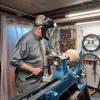Using a Whiteside 1414 Round-nose router bit in a drill chuck on a lathe. Tell me why it is a dumb idea.
The 1414 is a 1-1/4 diameter round nose bit. I am wondering if this could help me form the bottom of the cup of a small chalice.
Another alternative would be the 1376B Bowl and Tray Bit, also 1-1/4 " across.
I have made about 50 of the small chalices, 1-3/4" inches wide by about 7" long. The cup is about 2-1/2" deep. I use a 1-1/4" forstner to begin the hole, but small tools like scrapers chatter on the bottom and my boring bar is too clumsy for that size (and my skills). So most of the chalices have a ring on the bottom from the forstner.
Or I could get a dedicated hollowing tool, at which point wise people tell me to save for a hollowing system, which I will. But I don't have that money at the moment.
Please tell me why this is an idiotic, broken, no good idea.





 Reply With Quote
Reply With Quote







